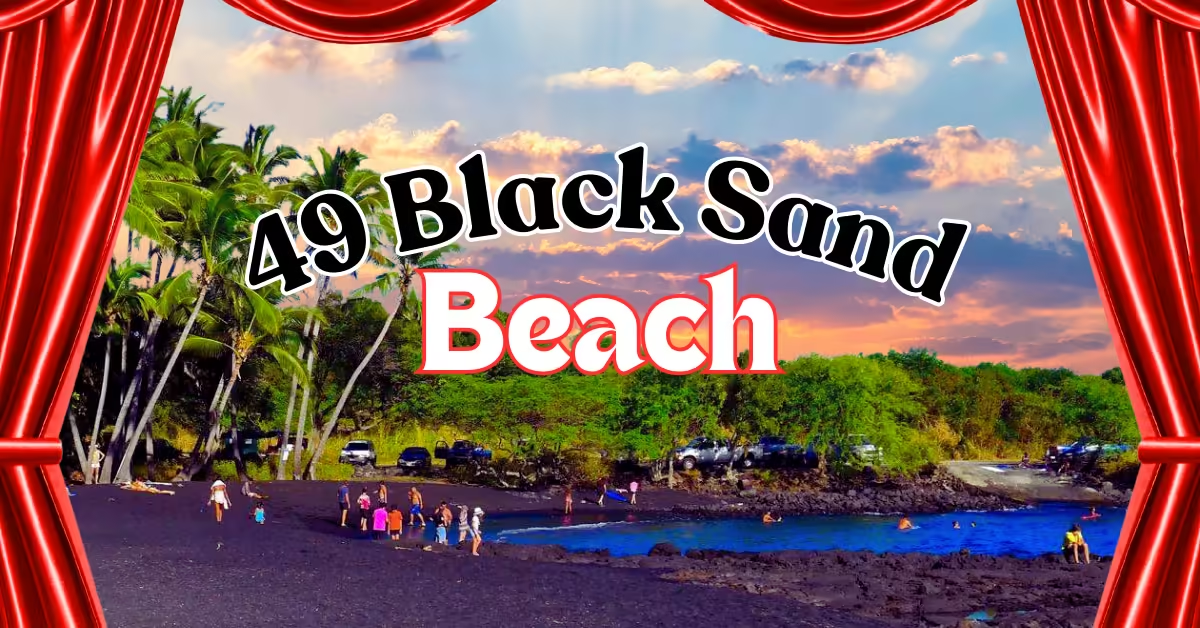Introduction
Hawaii’s stunning natural beauty is known across the globe, with its beaches among the most famous attractions. But not all of Hawaii’s beaches are made up of the traditional golden sands you might imagine. One of the most unique and breathtaking spots you can visit is 49 Black Sand Beach, located on the Big Island. This black sand beach is not only striking in appearance, but it also offers a secluded escape from the more crowded tourist hotspots.
In this blog post, we’ll explore 7 reasons why 49 Black Sand Beach should be at the top of your list when visiting the Big Island of Hawaii. From its distinctive black sand to its pristine waters and natural beauty, you’ll discover why this hidden gem is a must-see for nature lovers, beachgoers, and adventurers alike. Let’s dive into what makes 49 Black Sand Beach such a standout destination.
1. What Is 49 Black Sand Beach? An Overview of This Unique Destination
Nestled along the Kohala Coast on the Big Island of Hawaii, 49 Black Sand Beach offers a striking contrast to the typical white sand beaches found throughout the Hawaiian Islands. This beach, officially known as Waialea Beach, is located in Waikoloa and is famous for its shimmering black volcanic sand, which was formed from the island’s ancient volcanic activity.
What makes 49 Black Sand Beach truly special is its secluded location and exclusive feel. Unlike many of the more crowded beaches on the island, this beach offers a tranquil setting, allowing visitors to truly unwind and take in the natural beauty. The beach is surrounded by lava rock formations and offers breathtaking views of the Pacific Ocean.
It’s important to note that 49 Black Sand Beach is part of a gated community, and while it’s a public beach, access is limited to a certain number of daily visitors. This adds to the private, peaceful atmosphere of the beach, making it perfect for those looking to escape the crowds.
2. The Origins of 49 Black Sand Beach: Why Is the Sand Black?
The black sand at 49 Black Sand Beach is a result of the volcanic activity that shaped the Big Island of Hawaii. Unlike traditional beaches, which are formed from coral and shell fragments, black sand beaches are made from lava rock that has eroded over time. As molten lava from the island’s volcanoes flows into the ocean, it cools rapidly, shattering into tiny fragments that eventually form black sand.
49 Black Sand Beach is unique in that its sand is composed of basalt, a volcanic rock that gives the beach its deep, rich black color. The contrast between the dark sand, the bright blue water, and the surrounding lava rock formations creates a stunning visual experience that’s unlike any other beach on the island.
Hawaii is home to several black sand beaches, but 49 Black Sand Beach stands out for its seclusion and the beauty of its surroundings. The black sand not only provides a unique aesthetic but also reflects the rich geological history of the island. Standing on the beach, you’re literally standing on the remnants of volcanic eruptions that helped shape the island’s landscape.
While the black sand is mesmerizing, it’s important to remember that black sand can get extremely hot under the sun, so be sure to bring appropriate footwear to protect your feet during your visit.
3. Top Activities at 49 Black Sand Beach: What to Do and See
Despite its secluded nature, 49 Black Sand Beach offers plenty of activities for visitors looking to enjoy the natural beauty of the area. Here are some top things to do at this unique Hawaiian beach:
1. Relax and Enjoy the Scenic Views
One of the most popular activities at 49 Black Sand Beach is simply relaxing on the sand and soaking in the views. The contrast of the black sand against the blue waters makes for a truly breathtaking sight, and with fewer crowds, it’s easy to find a quiet spot to unwind.
2. Snorkeling
The waters around 49 Black Sand Beach are relatively calm, making it a great spot for snorkeling. There’s a diverse array of marine life to explore, including colorful fish, coral, and even sea turtles. Be sure to bring your snorkeling gear, as there are no rental facilities on-site.
3. Swimming
Swimming is generally safe at 49 Black Sand Beach, thanks to the beach’s sheltered location and calm waters. However, as with any beach, it’s important to keep an eye on the ocean conditions and be cautious of any currents.
4. Hiking and Exploring
The lava rock formations surrounding the beach make for great opportunities to explore. You can take a walk along the coast to enjoy the natural beauty and see some of Hawaii’s unique volcanic terrain up close.
Whether you’re looking to relax, snorkel, or explore, 49 Black Sand Beach offers something for everyone, making it a must-visit destination for nature lovers. If you’re a fan of epic coastal adventures, don’t miss out on surfing in Portugal during November—it’s the perfect time to catch thrilling waves! Learn more here.
4. Wildlife and Marine Life: Exploring the Natural Beauty of 49 Black Sand Beach
One of the most exciting aspects of visiting 49 Black Sand Beach is the chance to experience the rich wildlife and marine life that thrive in the area. The calm waters around the beach are home to a variety of fascinating species, making it a great destination for snorkelers and nature enthusiasts alike.
Turtles
Hawaiian green sea turtles, or honu, are a common sight at 49 Black Sand Beach. These majestic creatures can often be seen swimming in the waters near the shore or basking on the black sand. As these turtles are a protected species, it’s important to observe them from a distance and avoid touching or disturbing them.
Fish and Coral
The waters around 49 Black Sand Beach are teeming with a variety of tropical fish and vibrant coral reefs. Visitors who choose to snorkel will be treated to colorful species such as parrotfish, angelfish, and surgeonfish swimming amongst the coral formations. The coral reefs in this area are relatively healthy and provide a critical habitat for marine life.
Bird Watching
The Kohala Coast, where 49 Black Sand Beach is located, is home to numerous bird species. Visitors might spot shorebirds such as black-crowned night herons or the rare Hawaiian hawk soaring above the beach. Bird watchers will enjoy the serene setting while observing these fascinating creatures in their natural habitat.
Whether you’re snorkeling, swimming, or simply watching from the shore, the rich diversity of wildlife and marine life at 49 Black Sand Beach adds another layer of wonder to your visit.
5. Is Swimming Safe at 49 Black Sand Beach?
Swimming at 49 Black Sand Beach is generally considered safe due to its relatively calm waters and sheltered location along the Kohala Coast. The natural formation of the coastline provides some protection from the stronger currents and waves found at other beaches on the Big Island. However, it’s important to be mindful of a few key factors when swimming here:
1. Ocean Conditions
While the waters are typically calm, conditions can change throughout the day. Pay attention to ocean advisories and signs posted at the beach entrance. On windy or stormy days, waves and currents can become stronger, so it’s crucial to monitor the water and avoid swimming if conditions look hazardous.
2. Shallow Entry
The beach has a gradual, shallow entry into the water, which makes it an ideal spot for wading and swimming for beginners or families with children. The black sand also contributes to the clarity of the water, making it easier to spot marine life and navigate the shoreline.
3. Snorkeling Safety
If you plan to snorkel at 49 Black Sand Beach, be sure to stay within designated areas and avoid swimming too far from the shore. While the beach’s calm waters make it great for snorkeling, the presence of lava rocks and coral reefs means that swimmers should be cautious and avoid stepping on fragile marine life.
Overall, 49 Black Sand Beach is a safe and enjoyable place for swimming, but it’s always important to stay aware of your surroundings and follow any safety guidelines posted at the beach.
6. Hiking to 49 Black Sand Beach: A Must-Do Experience
One of the most memorable ways to access 49 Black Sand Beach is by taking the scenic hike through the volcanic landscape that leads to the beach. Although the hike is relatively short, it offers a unique experience that combines stunning coastal views, lava fields, and native Hawaiian vegetation. Here’s what you can expect:
1. Starting Point
The trailhead to 49 Black Sand Beach begins at the parking lot near the gated community of the 49 Black Sand Beach Resort. The hike itself is about 0.5 miles each way and takes around 10 to 15 minutes to complete. The trail is clearly marked and accessible to most hikers, though the terrain can be uneven due to the presence of lava rocks.
2. Lava Fields and Rock Formations
As you walk along the trail, you’ll pass through fascinating lava fields that were created by ancient volcanic eruptions. The contrast between the dark, rugged lava rock and the lush greenery that grows around it offers a striking visual experience. Be sure to take your time and admire the lava rock formations along the way.
3. Scenic Ocean Views
As you approach the beach, you’ll be rewarded with breathtaking views of the Pacific Ocean and the Kohala coastline. The hike provides plenty of opportunities to stop and take in the scenery, making it a rewarding experience even before you reach the black sand beach.
The hike to 49 Black Sand Beach is an easy and enjoyable experience that adds an extra layer of adventure to your visit. Whether you’re a seasoned hiker or just looking for a short nature walk, this trail is a must-do for anyone visiting the area.
7. Tips for Visiting 49 Black Sand Beach: What You Should Know Before You Go
Before you head out to 49 Black Sand Beach, there are a few important things to keep in mind to ensure you have the best experience possible. Here are some tips for visiting this hidden gem on the Big Island:
1. Arrive Early
As mentioned earlier, parking is limited, and access to the beach is controlled through a gated entrance. Arriving early in the morning will increase your chances of securing a parking spot and avoiding the midday heat. The beach opens at sunrise, so plan to get there as soon as possible.
2. Bring Sun Protection
The black sand at 49 Black Sand Beach absorbs and reflects a lot of heat, making the beach quite warm, especially during midday. Be sure to bring plenty of sunscreen, a hat, and protective clothing to avoid sunburn. Additionally, pack sandals or water shoes to protect your feet from the hot sand.
3. Pack Snacks and Water
Since 49 Black Sand Beach is located in a somewhat remote area, there are no facilities or food vendors nearby. Be sure to bring plenty of water and snacks to keep yourself hydrated and energized during your visit.
4. Respect Wildlife and the Environment
Remember that 49 Black Sand Beach is a natural and protected area. Be mindful of the wildlife, including sea turtles and birds, and avoid disturbing them. Additionally, do not remove any of the black sand as a souvenir—it’s important to leave the beach as pristine as you found it for future visitors to enjoy.
By following these tips, you’ll be well-prepared to enjoy a peaceful and memorable visit to one of Hawaii’s most unique beaches.
FAQs About 49 Black Sand Beach
- Where is 49 Black Sand Beach located?
49 Black Sand Beach is located along the Kohala Coast on the Big Island of Hawaii, near the town of Waikoloa. - Is 49 Black Sand Beach a public beach?
Yes, 49 Black Sand Beach is a public beach, though access is limited due to its location within a gated community. Parking is available on a first-come, first-served basis. - What makes 49 Black Sand Beach unique?
The beach is known for its black volcanic sand, which was formed from ancient lava flows. Its secluded location and natural beauty make it a standout destination on the Big Island. - Is swimming safe at 49 Black Sand Beach?
Yes, swimming is generally safe at 49 Black Sand Beach due to the calm waters. However, it’s important to monitor ocean conditions and be cautious of any strong currents. - Can I snorkel at 49 Black Sand Beach?
Yes, snorkeling is popular at 49 Black Sand Beach. The waters are home to a variety of marine life, including tropical fish and sea turtles. - How do I get to 49 Black Sand Beach?
Visitors can access the beach by parking at the entrance to the gated community and hiking a short trail to the beach. Arriving early is recommended to secure a parking spot. - What should I bring when visiting 49 Black Sand Beach?
Be sure to bring sun protection, plenty of water, and comfortable shoes for walking on the hot black sand. There are no facilities at the beach, so plan accordingly. - Are there any wildlife species to look out for?
Yes, visitors often spot Hawaiian green sea turtles and various species of tropical fish while swimming or snorkeling near the beach. - Can I take black sand from the beach as a souvenir?
No, it’s illegal to take black sand from 49 Black Sand Beach or any of Hawaii’s other black sand beaches. Removing the sand disrupts the natural environment. - What is the best time of year to visit 49 Black Sand Beach?
The best times to visit are during the spring (April to May) and fall (September to October) when the weather is pleasant, and there are fewer crowds.
Conclusion
49 Black Sand Beach is a must-visit destination for anyone traveling to the Big Island of Hawaii. With its striking black volcanic sand, calm waters, and abundance of wildlife, it offers a unique beach experience that you won’t find anywhere else. Whether you’re looking to relax, swim, or snorkel, this beach provides a peaceful escape from the more crowded tourist spots. The scenic hike to the beach, coupled with the chance to explore the natural surroundings, makes 49 Black Sand Beach a hidden gem worth discovering.
By following the tips and guidelines in this post, you’ll be well-prepared to enjoy all that 49 Black Sand Beach has to offer while helping to preserve its beauty for future generations. From the black sand to the wildlife, every part of this beach tells the story of Hawaii’s volcanic origins, making it a destination that is both beautiful and historically significant.

Joseph Bush is a seasoned writer and researcher with over 7 years of experience covering a wide range of general topics, from lifestyle and technology to business and current events. He is dedicated to producing fact-checked, reader-friendly content that informs, engages, and empowers readers.
Throughout his career, Joseph has followed strict editorial guidelines, relied on reputable sources, and ensured every article meets the highest standards of accuracy and clarity. His expertise spans multiple fields, allowing him to explain complex topics in a way that’s easy to understand.
Passionate about continuous learning, Joseph stays updated on industry trends and best practices to deliver trustworthy, well-rounded insights. Readers can rely on his work for its credibility, depth, and real-world relevance.




